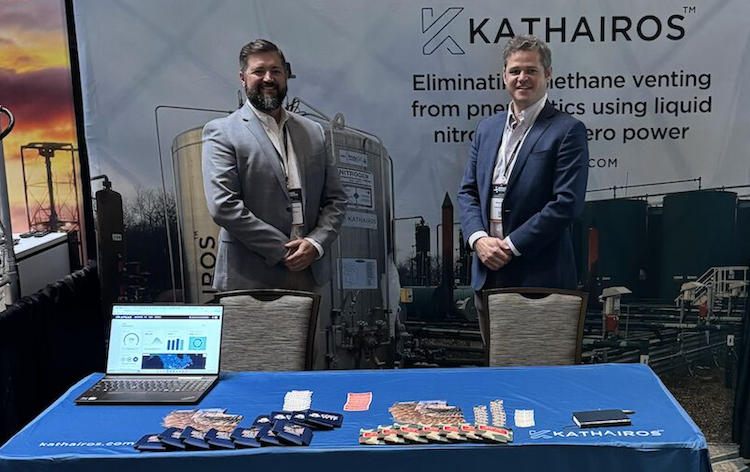
Kathairos has emerged as the leading North American solution for methane elimination from pneumatics, with more than 2,400 systems in operation across North America and over 70 major oil and gas producer partners.
In this post
Certain gases are able to trap heat in the atmosphere, making them very important players in the conversation about climate change.
These gases are known as greenhouse gases (GHGs) and they influence climate change based on several factors: abundance (or the total amount of gas in the air), duration (or the amount of time certain gases remain in the atmosphere) and potency (or how effectively these gases can trap heat in the atmosphere).
In particular, four types of greenhouse gases pose a significant challenge in the fight against climate change. Think of these gases like bosses in a video game: each gas has a specific set of powers, or chemical properties, that make it distinct from other types of greenhouse gases, but also makes it uniquely difficult to tackle.
What are they? How do we deal with them?
Carbon dioxide (CO2)
You can’t talk about climate change without talking about carbon dioxide: it is the main greenhouse gas emitted through human activities, accounting for at least 76% of total greenhouse gas emissions.
CO2 is that one boss that you just can't seem to take down: once emitted into the atmosphere, 40% of CO2 remains after 100 years, 20% after 1000 years, and 10% as long as 10000 years later.
While CO2 is naturally present in the atmosphere, human activity has drastically altered the carbon cycle, both by adding significant amounts of CO2 to the atmosphere and by changing the ability of natural carbon sinks (like forests and soils) to remove and store CO2 from the atmosphere. The main human activity that emits CO2 is the combustion of fossil fuels (including coal, natural gas and oil) for energy, industry and transportation.
The most significant human activities that produce CO2 emissions all involve the combustion of fossil fuels. Naturally, the easiest way to reduce CO2 emissions? Reduce fossil fuel consumption. Whether by increasing energy efficiency as a means of reducing energy use, conserving energy or by switching to fuels with lower carbon contents, there are many common-sense actions to take to reduce CO2 emissions.
Even more, several new technologies and strategies are emerging to tackle the CO2 problem, including Carbon Capture and Sequestration (CCS). This set of technologies has the potential to greatly reduce CO2 emissions from coal- and gas-fired power plants, industrial processes and other sources of CO2 by capturing the CO2 emissions before they are released into the atmosphere, then transporting the gas via pipelines underground for storage.
Methane (CH4)
Methane is the second-most important greenhouse gas, accounting for at least 17% of global greenhouse gas emissions and at least 25% of the warming we are experiencing.
There are natural sources for CH4, like wetlands, but 50-65% of global methane emissions come as a result of human activities, including agriculture, fuel combustion and waste management. While methane’s atmospheric lifetime is much shorter than carbon dioxide’s, it is significantly more efficient at trapping radiation: pound for pound, the comparative impact of CH4 on climate change is 25x greater than CO2 over a 100-year period!
Agriculture accounts for the most CH4 emissions of any industry, due to the CH4 produced by domestic livestock as part of the digestive processes and the buildup of CH4 produced when manure is stored. Because CH4 is the primary component of natural gas, CH4 is emitted during the production, processing and distribution of natural gas, as well as the production, transportation and storage of crude oil. CH4 generated in landfills and during wastewater management account for the third most emissions of any industry.
Increasingly more ways to tackle the CH4 problem are emerging as its environmental impacts become better understood. In fact, the Global Methane Initiative exists as an international partnership advocating for the widespread adoption of global CH4 reduction strategies. Both the agricultural and waste management sectors are looking into altering manure management strategies, while the energy industry is upgrading equipment to reduce gas leaks that play a significant role in CH4 emissions and continues to champion innovations to reduce, capture or circumvent CH4 emissions.
Nitrous oxide (N2O)
Nitrous oxide is naturally present in the atmosphere as part of the planet’s nitrogen cycle, but human activities such as agriculture, wastewater management and industrial processes are increasing the amount of N2O in the atmosphere.
In fact, human activities account for nearly 40% of total N2O emissions. N2O molecules are long-lived, remaining in the atmosphere for an average of 114 years before they are removed by a nitrogen sink or broken down through a series of chemical reactions. The problem? The warming impact of 1 pound of N2O on climate change is almost 300x that of 1 pound of CO2.
Certain soil management strategies, including fertilizer application, manure management and the burning of agricultural residues produce N2O. It is also generated as a by-product during the production of both nitric acid (used to make synthetic fertilizers) and adipic acid (used to make synthetic fibers, including nylon).
Shifting away from nitrogen-based fertilizers and modifying manure management can significantly reduce emissions, since the application of nitrogen-based fertilizers accounts for over 80% of global N2O emissions! Technological upgrades in industry as well as fuel switching are also very realistic strategies to prevent N2O emissions during the production of synthetic acids.
Fluorinated gases
There are four main categories of fluorinated gases: hydrofluorocarbons (HFCs), perfluorocarbons (PFCs), sulfur hexafluoride (SF6), and nitrogen trifluoride (NF3).
So, what exactly makes these gases so special, apart from the fact that they all sound like they are written in a different language? They are the only gases to lack any natural sources and come exclusively from human-related activities. Over 90% of emitted fluorinated gases come from those used as substitutes for ozone-depleting substances, like refrigerants, with the rest coming from other industrial processes, including aluminum and semiconductor manufacturing.
Many of these gases have very high global warming potentials relative to other greenhouse gases, so even small atmospheric concentrations of fluorinated gases can drastically impact global temperatures. In general, fluorinated gases are the most potent and longest lasting type of greenhouse gases, persisting in some cases for thousands of years until they are broken down by sunlight in the far upper atmosphere.
HFCs constitute the majority of fluorinated gas emissions due to their widespread use as refrigerants, propellants, solvents and retardants. HFCs were developed to replace chlorofluorocarbons (CFCs) and hydrochlorofluorocarbons (HCFCs), which are other fluorinated gases that, unlike HFCs, deplete stratospheric ozone and further contribute to global warming.
While better management of HFCs during the servicing, operation and disposal of any relevant equipment can help ensure that HFC emissions remain minimal, industries are continuing to look towards transitioning to next-generation technologies that do not rely on HFCs. In fact, the shift away from HFCs and fluorinated gases remains one of the most important climate actions to take today.
Explore more posts from Kathairos

RSVP: North America’s Best Energy, Oil & Gas Conferences and Events in 2026
.png)
What You Need to Know About Canada’s Final Methane Regulations—and How They Align with the Alberta MOU

